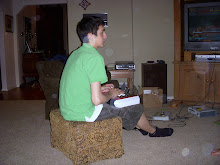In my last post I made it a pretty big impression that I wanted to learn how to anti air better. While playing today, a thought finally dawned on me on how I can exactly strengthen my anti air game. I realized that there were specific times that my opponent was jumping in on me. I even mentioned this in the post yesterday...I seem to have troubles anti air'ing after throwing a fireball and also during poking battles (using c.mk's and hadou's from closer ranges). Basically I'm finding it hard to control the air AND ground both at the same time. I started looking at anti air's a bit more in depth, and here's what I came up with...
There are 3 different types of anti airs when using Ryu. I'm not talking about different anti air types as far as HOW you can anti air, but instead I'm talking about situations WHEN you anti air...there are 3 of them:
- Idle anti air: this is the easiest to hit as your just waiting for your opponent to jump in on you. Not only are you waiting for the jump, but your expecting the jump, so your looking for the anti air and are prepared to bust it out when you need to. In this situation, no pokes are being thrown out or anything (thus being idle). There are no distractions from the anti air...basically during t
hese "idle anti airs" your ONLY focusing on air control...not on ground control.
- Blocking anti air: This situation is kinda strange...it happens when your opponent has momentum over you, putting you in a defensive mindset. The problem is that the opponent feeds off of this, sees that your clamming up, then BAM jump in city. For me
personally, I find myself walking back (to distance myself from my opponent) and getting jumped in on...in turn giving them free momentum, putting me in a sticky position. It's hard to go from the motion of back (block), to forward (for the shoryuken motion) in time to catch the opponent's jump in. All this is still a tough situation to anti air your opponent, and it's something key to work at in order to have a great all around anti air game.
- Ground game anti air: This situation is MUCH different then an idle anti air or a blocking anti air. In this situation, Ryu's using attacks like c.mk's and fireballs in order to compete with ground zoning. This makes anti air'ing VERY difficult as it's hard to focus on both air AND ground control. A lot of times, I find myself sticking out a c.mk, and BAM my opponent is soaring in the air coming at me with a jumping attack. Now in about 9 times out of 10, I'm ALWAYS able to block, however the point is that I've given my opponent an opening and free momentum that he really didn't earn. Secondarily there's a saying that I try to live by which is "If you could block a jump in, you could have anti air'ed it." All in all, the point of the matter is that I'm giving away an opening when I could have stopped it...and had I better anti air skill, I'd be able to stop this situation from happening.
I would say that against a good player anti air situations look a bit like this: Idle anti airs = 10%, blocking anti airs = 20%, Ground game anti airs = 70%. The key to succesfully anti airing while playing the ground game, is to ALWAYS be on the look out for jump in's PERIOD. Don't limit yourself to only look for jump in's during idle stances. Instead realize the possibility that the opponent could jump in during the footsy/spacing battle, or while they're applying pressure. Hopefully this shines a bit of light on the different types of anti airs, and hopefully I can start strengthen'ing my anti air game after realizing all of this!
- Mickey D'



 at they're "always getting jumped in on" when they throw fireballs. This is a result of not throwing fireballs smart. The player didn't calculate the risks of throwing the fireball, and they OBVIOUSLY didn't calculate the rewards of throwing the fireball either. By understanding the risk/reward factor, you play knowing all the possibilities of what your opponent has as well as what YOU have.
at they're "always getting jumped in on" when they throw fireballs. This is a result of not throwing fireballs smart. The player didn't calculate the risks of throwing the fireball, and they OBVIOUSLY didn't calculate the rewards of throwing the fireball either. By understanding the risk/reward factor, you play knowing all the possibilities of what your opponent has as well as what YOU have. 
